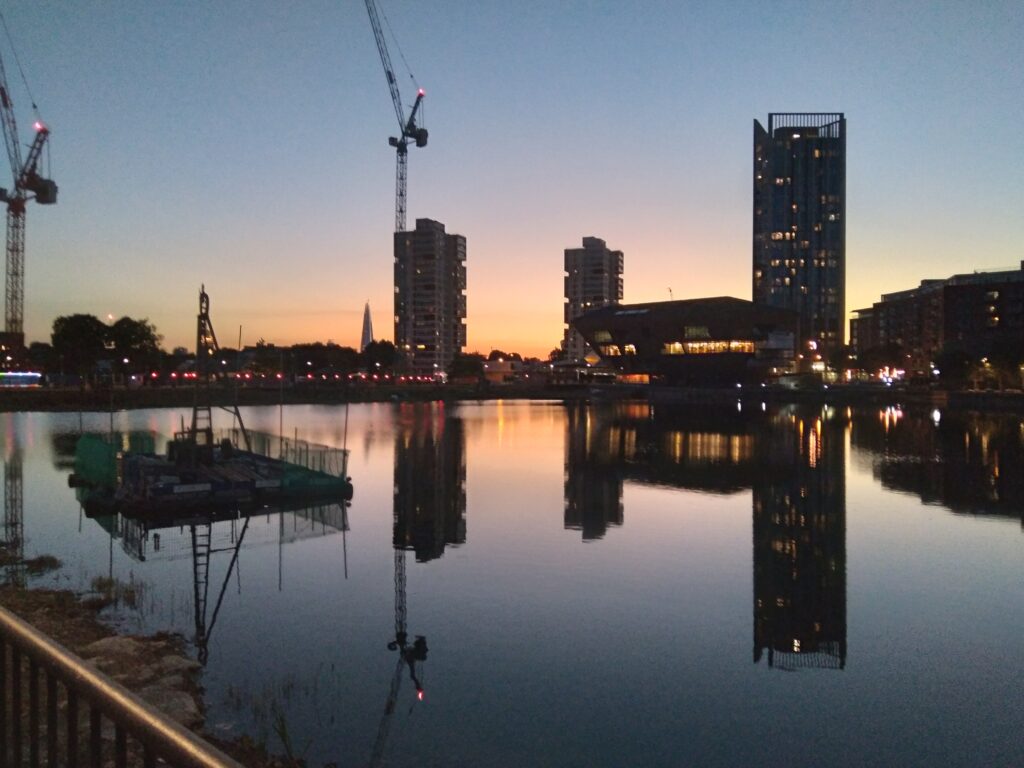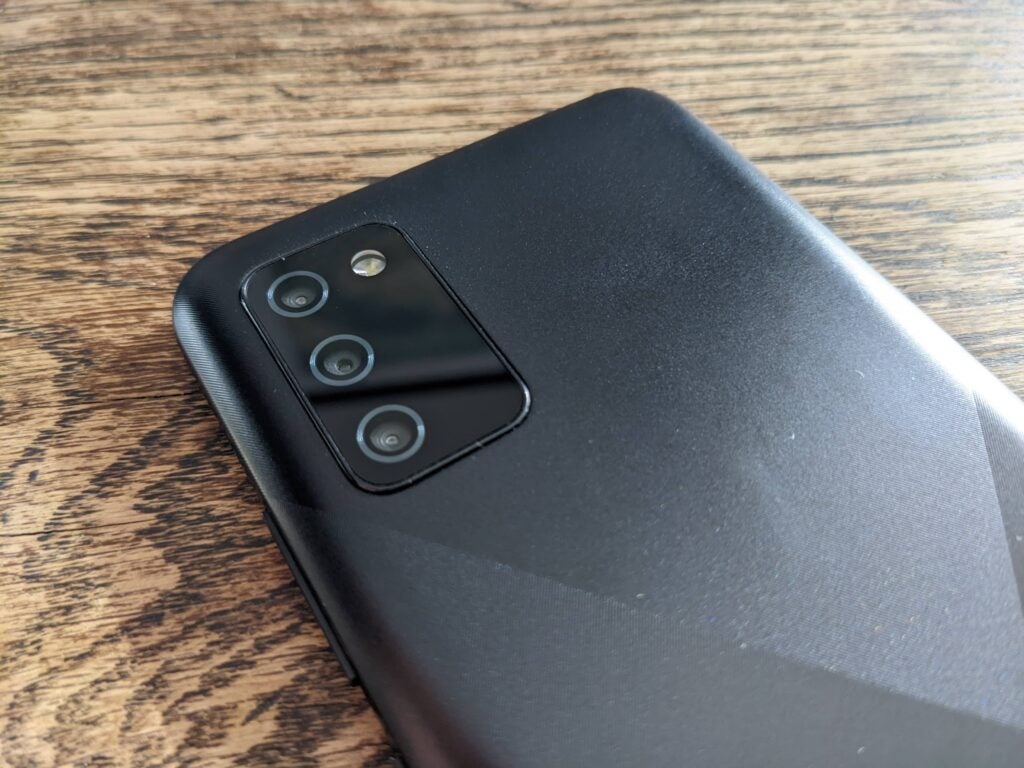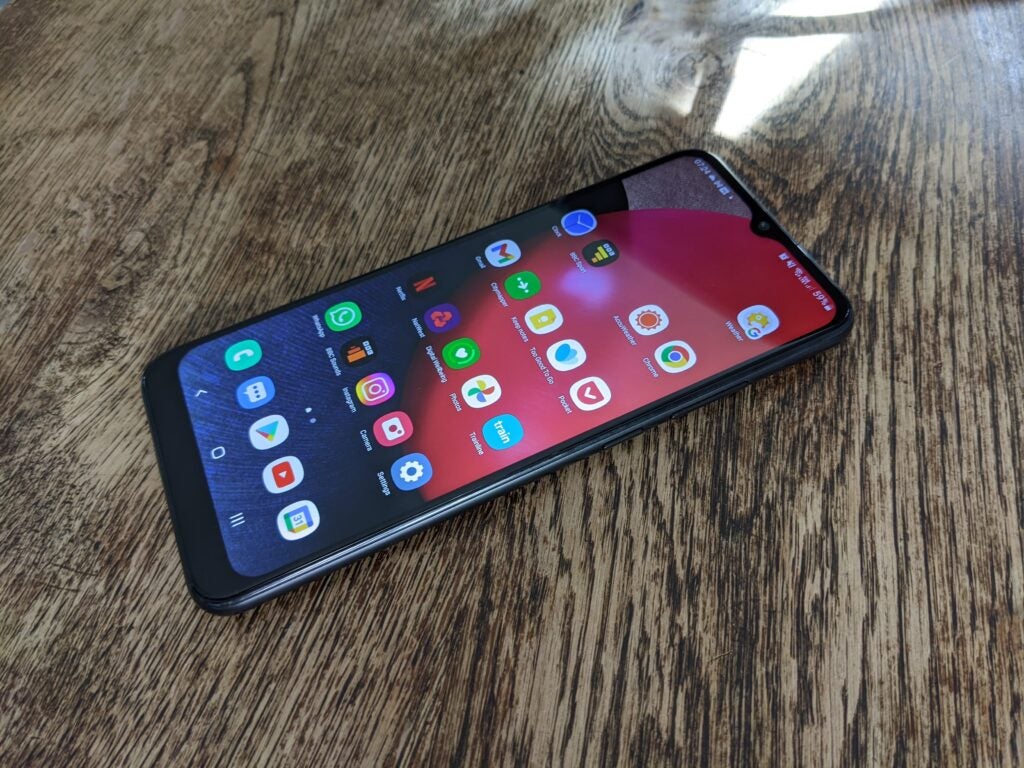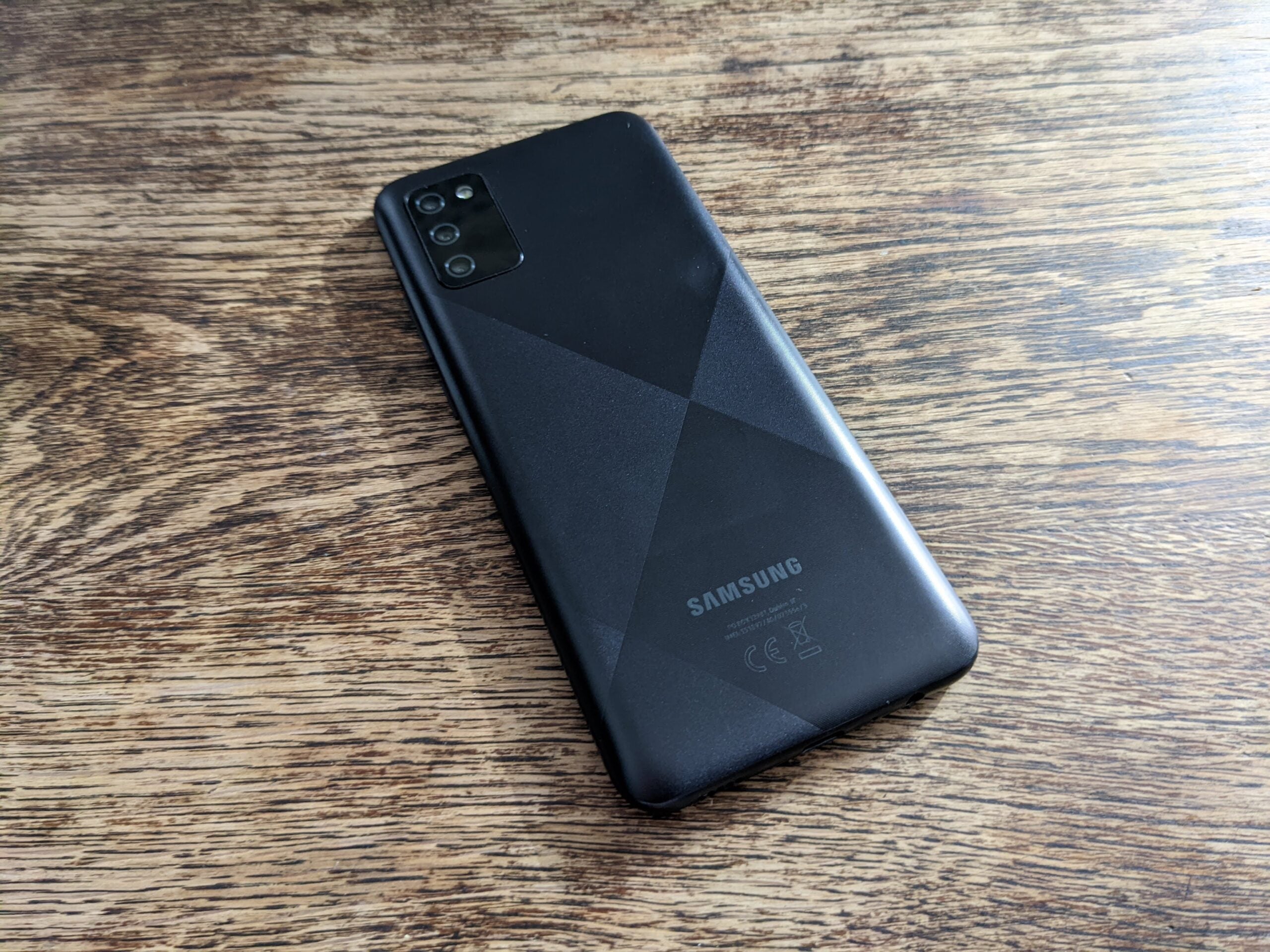The Samsung Galaxy A02s is an incredibly cheap smartphone that ticks a lot of key boxes. However, the positives – which include impressive battery life, expandable storage and a lovely design – need to be offset against the negatives. Here, it’s the camera and general performance that are found lacking.
Pros
- Solid build
- Attractive design
- Excellent battery life
Cons
- Stuttering performance
- Poor camera
- No fingerprint scanner
Availability
- UKRRP: £139
- USATBC
- EuropeTBC
- CanadaTBC
-
5000mAh batteryThis devices offer a generous battery capacity -
6.5-inch displayIt comes sporting a large 1600 x 720-resolution LCD panel -
MicroSD card slotYou can expand the handset’s onboard storage via microSD card
Introduction
The Samsung Galaxy A02s is one of the cheapest smartphones in Samsung’s range. Costing just £120, it offers a large screen, long-lasting battery life and expandable storage; but there are some notable areas in which it struggles.
The camera is poor and performance can be laggy – but if your budget is restricted, the Galaxy A02s is a compelling package.
Design and Screen
- Textured plastic body
- 6.5-inch, 1600 x 720 display
- No fingerprint sensor
- Face scanner
The Samsung Galaxy A02s is brilliantly designed and well constructed.
The plastic chassis feels soft to the touch yet also solid and durable, and the subtly textured, multi-toned and diamond-patterned back panel is pleasing on the eye. And since it sports a matte finish, it also does a good job of keeping greasy fingerprint marks at bay.
The A02s certainly doesn’t look like a sub-£150 phone.

The three rear cameras sit within a rectangular module that protrudes somewhat, but not so much that it prevents the phone from lying flat on a tabletop, which is nice.
The power button and volume keys sit along the phone’s right-hand edge, and both are within easy reach. They’re a little on the mushy side but function reliably; however, it’s disappointing that the power button doesn’t double-up as a fingerprint scanner.
The Galaxy A02s forgoes a fingerprint reader altogether, but there is biometric scanning in the form of a face sensor, which relies on the selfie camera that sits within a teardrop-style notch at the top of the display.

It isn’t an adequate substitute, to the extent that you’ll have to revert to the basic PIN or pattern method most of the time instead.
On the plus side, it’s always good to see a headphone jack and a microSD card slot, while the A02s also brings support for dual SIMs. A downward-firing mono speaker sits alongside the USB-C port on the bottom edge of the phone.

The Galaxy A02s uses a 6.5-inch, 1600 x 720 PLS LCD screen with an aspect ratio of 20:9 and a pixel density of 270ppi.
Peak brightness is my biggest gripe here. In bright sunlight you’ll have to find a way to cast shade on the Galaxy A02s in order to stand a chance of being able to view anything on it.
Otherwise, it’s large and sharp enough to meet most people’s needs, and generally excellent considering the price of this phone.
Camera
- Triple rear cameras
- 13-megapixel main camera
- Macro and depth lenses
It isn’t unusual to see triple or even quadruple cameras on a cheap smartphone these days, and it’s a trio of lenses that the Galaxy A02s settles on for its rear configuration.
Don’t get your hopes up too high, though, because the setup comprises a 13-megapixel main lens, a 2-megapixel macro camera and a 2-megapixel depth sensor. That’s about as basic as a triple camera gets, and it shows in the results.


Photos almost invariably look grainy and washed out. Even in good lighting conditions, colours tend to look dreary and lifeless, with a noticeable cold, blue tint casting a muted shadow over entire scenes.

In middling and dim light, the results are uglier still, with extreme noise in dark areas and overexposed highlights, even with HDR switched on. Unfortunately, there’s no Night Mode option to improve matters.
Portrait mode, which lets you adjust the depth of field to make your subject stand out, can produce pleasing results. Pro mode lets you dig into ISO, white balance and exposure, and both learn from and experiment with different photography settings.

There’s also a Panorama mode and a Macro mode, the latter of which is neither especially useful nor effective (as you can see above).
An unexpected and frustrating issue with the Galaxy A02s’s camera is speed.
On numerous occasions I’ve ended up with a blurry mess of a photo because the viewfinder and camera app have indicated that my picture has been shot and saved when, in fact, the camera was still in the process of capturing it. This has happened too many times to simply be put down to bad luck or a shaky grip. The only way to combat it is by holding your pose for longer than seems necessary.
Video is captured at 1080p at 30fps, and there’s no image stabilisation to help you out. The 5-megapixel selfie camera is basic, but improved by the inclusion of Portrait mode.
Confusingly, the camera app makes it appear as if you can use the selfie camera in Pro, Panorama and Macro modes, but attempting to do so activates the rear camera instead.

It’s hard to complain too much about a phone that costs this little, and a photo editing app can improve the look of all but the worst pictures. Nevertheless, what’s frustrating is that the mention of a triple camera feels like a cheap marketing ploy that’s designed to make the camera appear more advanced than it is.
Performance
- Qualcomm Snapdragon 450 chip
- 3GB of RAM
- Android 11 with Samsung One UI
The Galaxy A02s is a sluggish phone, but that doesn’t relay the whole story; there are high points, too.
It runs on a Snapdragon 450 chip, which invites a brief trip down memory lane – it’s the same hardware that powered the HTC Desire 12 Plus and Motorola Moto G6 all the way back in 2018.
First impressions are poor. Even the simplest interactions are blighted by lag, which makes typing a less than pleasant experience, plus you always have to wait a fraction of a second for apps to launch. It isn’t as cripplingly bad as the MediaTek Helios MT6765-powered Samsung Galaxy A12, which is without doubt the slowest phone I’ve ever used, but it’s a long way from slick.

The Galaxy A02s often loses itself in its own system animations, which are, without fail, juddery and painful to watch. Turning animations off at least draws less attention to its speed woes. Multi-tasking is a source of genuine frustration, since apps tend to get pushed out of the phone’s memory extremely quickly.
For instance, when running Google Chrome and Spotify at the same time, the screen momentarily freezes whenever I switch between the two apps, as though it needs a second to regain its bearings before it lets you use either of them. These aren’t long delays, but after a while they can become annoying.
My review unit is the 3GB model, and it’s possible that the 4GB version is capable of delivering a better user experience.
Unexpectedly, the Galaxy A02s plays games and streams video without a hitch. Asphalt 8 showed no signs of lag whatsoever, with gameplay as smooth as you’d like it to be. In addition, streaming apps such as Netflix, YouTube and BBC iPlayer worked just as they should.
Benchmark test comparison
The Galaxy A02s runs Android 11 under Samsung’s One UI skin, which means it comes pre-loaded with lots of apps that most users probably wouldn’t use – the Samsung browser, Galaxy Store, Samsung’s own calendar app, and TikTok, for example. Some of these can be uninstalled; but others can’t.
The best thing about the Galaxy A02s’s software is that it’s future-proofed for at least the next couple of years. It’s in line for the Android 12 and One UI 4.0 upgrades.
Battery Life
- 5000mAh battery
- Phone easily lasts a day
- 15W charging
Battery life is a serious issue, especially with high-end phones, so the Galaxy A02s’s impressive stamina is one of its key selling points.
Unfortunately, it wasn’t able to run the 3DMark Wild Life Stress Test, which is one of Trusted Reviews’ go-to battery life benchmarks, but real-life use generated impressive results.
It lost 11% of its battery after an hour of streaming Netflix; half-an-hour of intensive gaming (Asphalt 8) used up 6%; and half-an-hour of light gaming (Threes) consumed only 2%. You can also stream music for hours without a worry. An hour of online music streaming used up 4% of the Galaxy A02s battery, and an hour of offline music streaming used up 3%.
You can easily get a day of use, sometimes two days, from a single charge – which means you’ll rarely face the prospect of the phone running flat before you get home after work or an evening out. It’s hard to put a value on peace of mind.
On the scarce occasions that the battery does run flat, you’ll want to ensure you have plenty of time to charge it. A full 0-100% charge took a whopping 3hrs 45mins, while getting it from flat to 50% required 1hr 35mins of charging.
Latest deals
Should you buy it?
A super-cheap phone that looks nice and offers great battery life.
The camera is poor and performance leaves a bit to be desired.
Final Thoughts
If £120 is as far as your budget will stretch, you could do far worse than the Samsung Galaxy A02s – a fairly ordinary smartphone that delivers extraordinary value for money. Battery life is excellent, it runs on a recent build of Android and One UI, and it’s a looker too.
If you can afford to spend a little more, the Motorola Moto G8 is another sub-£200 handset that we consider to be one of the best cheap phones on the market right now. It’s a notable upgrade, both in the performance and camera departments – which are the Galaxy A02s’s problem areas.
How we test
We test every mobile phone we review thoroughly. We use industry standard tests to compare features properly and we use the phone as our main device over the review period. We’ll always tell you what we find and we never, ever, accept money to review a product.
Used as our main handset during test period
Camera tested in variety of situations with all modes
Tested with synthetic benchmarks and real world use
FAQs
No, there’s no official IP rating so we can’t be sure how this device will react to potential water and dust ingress.
It’s available in black, white, red and blue.
Trusted Reviews test data
1 hour music streaming (online)
Time from 0-100% charge
1 hour music streaming (offline)
30 minute gaming (light)
30 minute gaming (intensive)
1 hour video playback (Netflix, HDR)
Geekbench 5 multi core
Geekbench 5 single core
3D Mark – Wild Life
3D Mark – Sling Shot
3D Mark – Sling Shot Extreme
Sustainability
TrustedReviews’ holds the fact that global warming is not a myth as a core value and will continuously endeavor to help protect our planet from harm in its business practices.
As part of this mission, whenever we review a product we send the company a series of questions to help us gauge and make transparent the impact the device has on the environment.
We currently haven’t received answers to the questions on this product, but will update this page the moment we do. You can see a detailed breakdown of the questions we ask and why in our sustainability info page.
Jargon buster
LCD
The type of display usually used on cheaper and mid-range devices. Lacks the punch on an OLED panel.
IP rating
An abbreviation for ‘Ingress Protection Code’, which lets you know to what extent a device might be waterproof or dustproof.
The Samsung Galaxy A02s is an incredibly cheap smartphone that ticks a lot of key boxes. However, the positives – which include impressive battery life, expandable storage and a lovely design – need to be offset against the negatives. Here, it’s the camera and general performance that are found lacking.
Pros
- Solid build
- Attractive design
- Excellent battery life
Cons
- Stuttering performance
- Poor camera
- No fingerprint scanner
Availability
- UKRRP: £139
- USATBC
- EuropeTBC
- CanadaTBC
-
5000mAh batteryThis devices offer a generous battery capacity -
6.5-inch displayIt comes sporting a large 1600 x 720-resolution LCD panel -
MicroSD card slotYou can expand the handset’s onboard storage via microSD card
Introduction
The Samsung Galaxy A02s is one of the cheapest smartphones in Samsung’s range. Costing just £120, it offers a large screen, long-lasting battery life and expandable storage; but there are some notable areas in which it struggles.
The camera is poor and performance can be laggy – but if your budget is restricted, the Galaxy A02s is a compelling package.
Design and Screen
- Textured plastic body
- 6.5-inch, 1600 x 720 display
- No fingerprint sensor
- Face scanner
The Samsung Galaxy A02s is brilliantly designed and well constructed.
The plastic chassis feels soft to the touch yet also solid and durable, and the subtly textured, multi-toned and diamond-patterned back panel is pleasing on the eye. And since it sports a matte finish, it also does a good job of keeping greasy fingerprint marks at bay.
The A02s certainly doesn’t look like a sub-£150 phone.

The three rear cameras sit within a rectangular module that protrudes somewhat, but not so much that it prevents the phone from lying flat on a tabletop, which is nice.
The power button and volume keys sit along the phone’s right-hand edge, and both are within easy reach. They’re a little on the mushy side but function reliably; however, it’s disappointing that the power button doesn’t double-up as a fingerprint scanner.
The Galaxy A02s forgoes a fingerprint reader altogether, but there is biometric scanning in the form of a face sensor, which relies on the selfie camera that sits within a teardrop-style notch at the top of the display.

It isn’t an adequate substitute, to the extent that you’ll have to revert to the basic PIN or pattern method most of the time instead.
On the plus side, it’s always good to see a headphone jack and a microSD card slot, while the A02s also brings support for dual SIMs. A downward-firing mono speaker sits alongside the USB-C port on the bottom edge of the phone.

The Galaxy A02s uses a 6.5-inch, 1600 x 720 PLS LCD screen with an aspect ratio of 20:9 and a pixel density of 270ppi.
Peak brightness is my biggest gripe here. In bright sunlight you’ll have to find a way to cast shade on the Galaxy A02s in order to stand a chance of being able to view anything on it.
Otherwise, it’s large and sharp enough to meet most people’s needs, and generally excellent considering the price of this phone.
Camera
- Triple rear cameras
- 13-megapixel main camera
- Macro and depth lenses
It isn’t unusual to see triple or even quadruple cameras on a cheap smartphone these days, and it’s a trio of lenses that the Galaxy A02s settles on for its rear configuration.
Don’t get your hopes up too high, though, because the setup comprises a 13-megapixel main lens, a 2-megapixel macro camera and a 2-megapixel depth sensor. That’s about as basic as a triple camera gets, and it shows in the results.


Photos almost invariably look grainy and washed out. Even in good lighting conditions, colours tend to look dreary and lifeless, with a noticeable cold, blue tint casting a muted shadow over entire scenes.

In middling and dim light, the results are uglier still, with extreme noise in dark areas and overexposed highlights, even with HDR switched on. Unfortunately, there’s no Night Mode option to improve matters.
Portrait mode, which lets you adjust the depth of field to make your subject stand out, can produce pleasing results. Pro mode lets you dig into ISO, white balance and exposure, and both learn from and experiment with different photography settings.

There’s also a Panorama mode and a Macro mode, the latter of which is neither especially useful nor effective (as you can see above).
An unexpected and frustrating issue with the Galaxy A02s’s camera is speed.
On numerous occasions I’ve ended up with a blurry mess of a photo because the viewfinder and camera app have indicated that my picture has been shot and saved when, in fact, the camera was still in the process of capturing it. This has happened too many times to simply be put down to bad luck or a shaky grip. The only way to combat it is by holding your pose for longer than seems necessary.
Video is captured at 1080p at 30fps, and there’s no image stabilisation to help you out. The 5-megapixel selfie camera is basic, but improved by the inclusion of Portrait mode.
Confusingly, the camera app makes it appear as if you can use the selfie camera in Pro, Panorama and Macro modes, but attempting to do so activates the rear camera instead.

It’s hard to complain too much about a phone that costs this little, and a photo editing app can improve the look of all but the worst pictures. Nevertheless, what’s frustrating is that the mention of a triple camera feels like a cheap marketing ploy that’s designed to make the camera appear more advanced than it is.
Performance
- Qualcomm Snapdragon 450 chip
- 3GB of RAM
- Android 11 with Samsung One UI
The Galaxy A02s is a sluggish phone, but that doesn’t relay the whole story; there are high points, too.
It runs on a Snapdragon 450 chip, which invites a brief trip down memory lane – it’s the same hardware that powered the HTC Desire 12 Plus and Motorola Moto G6 all the way back in 2018.
First impressions are poor. Even the simplest interactions are blighted by lag, which makes typing a less than pleasant experience, plus you always have to wait a fraction of a second for apps to launch. It isn’t as cripplingly bad as the MediaTek Helios MT6765-powered Samsung Galaxy A12, which is without doubt the slowest phone I’ve ever used, but it’s a long way from slick.

The Galaxy A02s often loses itself in its own system animations, which are, without fail, juddery and painful to watch. Turning animations off at least draws less attention to its speed woes. Multi-tasking is a source of genuine frustration, since apps tend to get pushed out of the phone’s memory extremely quickly.
For instance, when running Google Chrome and Spotify at the same time, the screen momentarily freezes whenever I switch between the two apps, as though it needs a second to regain its bearings before it lets you use either of them. These aren’t long delays, but after a while they can become annoying.
My review unit is the 3GB model, and it’s possible that the 4GB version is capable of delivering a better user experience.
Unexpectedly, the Galaxy A02s plays games and streams video without a hitch. Asphalt 8 showed no signs of lag whatsoever, with gameplay as smooth as you’d like it to be. In addition, streaming apps such as Netflix, YouTube and BBC iPlayer worked just as they should.
Benchmark test comparison
The Galaxy A02s runs Android 11 under Samsung’s One UI skin, which means it comes pre-loaded with lots of apps that most users probably wouldn’t use – the Samsung browser, Galaxy Store, Samsung’s own calendar app, and TikTok, for example. Some of these can be uninstalled; but others can’t.
The best thing about the Galaxy A02s’s software is that it’s future-proofed for at least the next couple of years. It’s in line for the Android 12 and One UI 4.0 upgrades.
Battery Life
- 5000mAh battery
- Phone easily lasts a day
- 15W charging
Battery life is a serious issue, especially with high-end phones, so the Galaxy A02s’s impressive stamina is one of its key selling points.
Unfortunately, it wasn’t able to run the 3DMark Wild Life Stress Test, which is one of Trusted Reviews’ go-to battery life benchmarks, but real-life use generated impressive results.
It lost 11% of its battery after an hour of streaming Netflix; half-an-hour of intensive gaming (Asphalt 8) used up 6%; and half-an-hour of light gaming (Threes) consumed only 2%. You can also stream music for hours without a worry. An hour of online music streaming used up 4% of the Galaxy A02s battery, and an hour of offline music streaming used up 3%.
You can easily get a day of use, sometimes two days, from a single charge – which means you’ll rarely face the prospect of the phone running flat before you get home after work or an evening out. It’s hard to put a value on peace of mind.
On the scarce occasions that the battery does run flat, you’ll want to ensure you have plenty of time to charge it. A full 0-100% charge took a whopping 3hrs 45mins, while getting it from flat to 50% required 1hr 35mins of charging.
Latest deals
Should you buy it?
A super-cheap phone that looks nice and offers great battery life.
The camera is poor and performance leaves a bit to be desired.
Final Thoughts
If £120 is as far as your budget will stretch, you could do far worse than the Samsung Galaxy A02s – a fairly ordinary smartphone that delivers extraordinary value for money. Battery life is excellent, it runs on a recent build of Android and One UI, and it’s a looker too.
If you can afford to spend a little more, the Motorola Moto G8 is another sub-£200 handset that we consider to be one of the best cheap phones on the market right now. It’s a notable upgrade, both in the performance and camera departments – which are the Galaxy A02s’s problem areas.
How we test
We test every mobile phone we review thoroughly. We use industry standard tests to compare features properly and we use the phone as our main device over the review period. We’ll always tell you what we find and we never, ever, accept money to review a product.
Used as our main handset during test period
Camera tested in variety of situations with all modes
Tested with synthetic benchmarks and real world use
FAQs
No, there’s no official IP rating so we can’t be sure how this device will react to potential water and dust ingress.
It’s available in black, white, red and blue.
Trusted Reviews test data
1 hour music streaming (online)
Time from 0-100% charge
1 hour music streaming (offline)
30 minute gaming (light)
30 minute gaming (intensive)
1 hour video playback (Netflix, HDR)
Geekbench 5 multi core
Geekbench 5 single core
3D Mark – Wild Life
3D Mark – Sling Shot
3D Mark – Sling Shot Extreme
Sustainability
TrustedReviews’ holds the fact that global warming is not a myth as a core value and will continuously endeavor to help protect our planet from harm in its business practices.
As part of this mission, whenever we review a product we send the company a series of questions to help us gauge and make transparent the impact the device has on the environment.
We currently haven’t received answers to the questions on this product, but will update this page the moment we do. You can see a detailed breakdown of the questions we ask and why in our sustainability info page.
Jargon buster
LCD
The type of display usually used on cheaper and mid-range devices. Lacks the punch on an OLED panel.
IP rating
An abbreviation for ‘Ingress Protection Code’, which lets you know to what extent a device might be waterproof or dustproof.

























